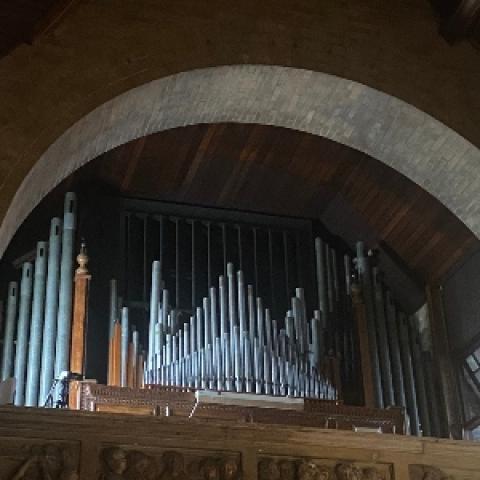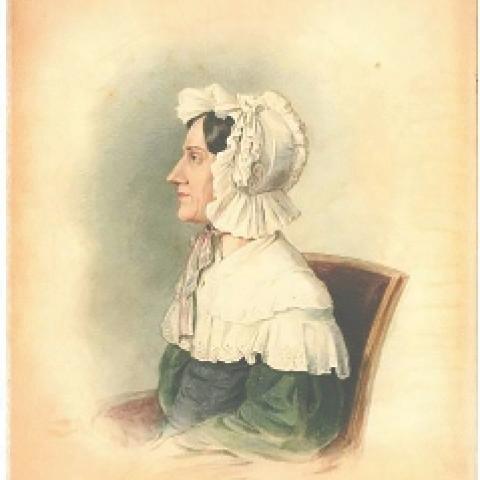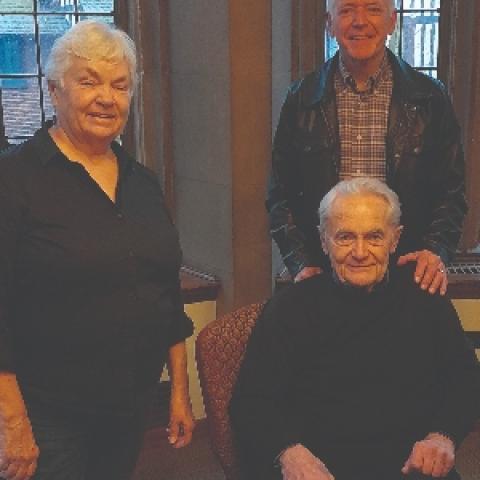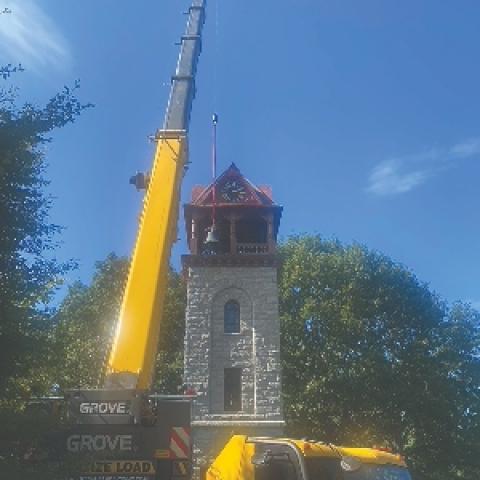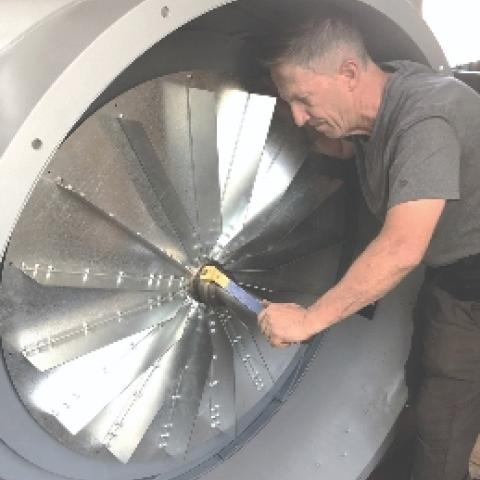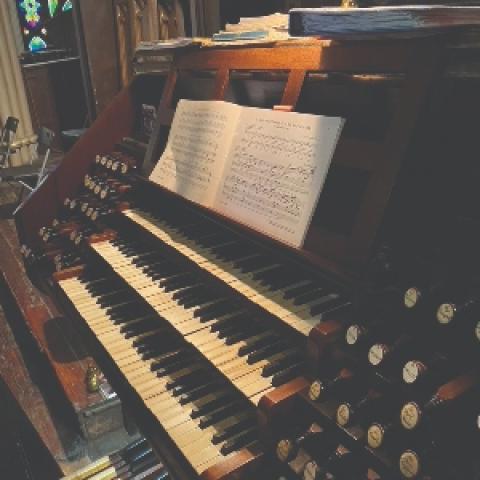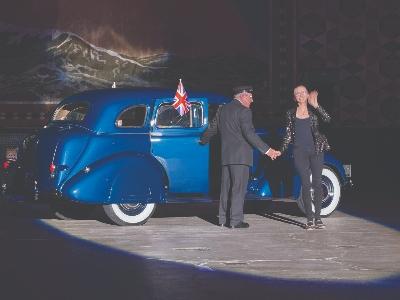
Adventures and transitions
In the last six weeks, Wendy and I have attended three singular events involving three very different pipe organs. One was small and in poor condition, another was a grand instrument in an iconic church, and the third was so large as to be off the charts. Most instruments have little variations in size—a violin is a violin, a trumpet is a trumpet—but pipe organs span huge ranges of size as well as styles and even purposes. These events provided a fun overview of extremes.
We traveled to Atlantic City, New Jersey, on April 5 to hear the brilliant young organist Anna Lapwood play a recital on the massive Midmer-Losh organ in Boardwalk Hall. No other organ in the world has ten 32′ ranks, and those are just ten of 447 ranks; the organ has 33,111 pipes. You can find the stoplist and list of ranks at boardwalkorgans.org. (See also the cover feature of the November 2020 issue.) There is an impressive restoration effort underway there, a daunting task being faced by a professional staff and a troupe of volunteers under the direction and curatorship of Nathan Bryson.
According to its website, the interior of Boardwalk Hall is 456 feet long, 310 feet wide, and 137 feet high. Remember that a football field is 300 feet long, and you might imagine the scale of the place. Among the activities in the hall beside organ recitals are car races, tractor pulls, and rock concerts, and it is the only space in the world that has hosted an indoor helicopter flight. In 1964 Lyndon Johnson was nominated to be a candidate for president of the United States during the Democratic National Convention in Boardwalk Hall.
The stage of Boardwalk Hall is 148 feet wide, and the main organ chambers flank the proscenium arch. The size of the organ and the number of expressive divisions were obvious to the audience as the organ chamber lights remained on throughout the concert. All the individual sections of the instrument were evident, and hundreds of huge shutters opened and closed suddenly and majestically.
Anna Lapwood is twenty-eight years old and has risen to international fame through her fantastic abilities, popular appeal, and masterful use of social media. Enter her name in search fields for Google, TikTok, Facebook, or YouTube, and one will find days of fun listening. She was recently appointed an MBE (Member of the British Empire) for her service to music. According to her official website, Anna “holds the position of director of music for Pembroke College (Cambridge), associate artist with Royal Albert Hall, and artist in association with the BBC Singers. In 2023 she was awarded the prestigious ‘Gamechanger’ award from the Royal Philharmonic Orchestra and signed to Sony Classical as an exclusive recording artist.”
Knowing that this would be a popular event among organists and organbuilders, I bought our tickets for Anna’s concert at Boardwalk Hall immediately after they went on sale in early February, and Wendy and I enjoyed our seats at a table on the main floor. Since Boardwalk Hall’s seating capacity is over 10,000 we were not worried about missing the concert. While the main floor was nearly full, the audience of around 1,200 people had plenty of space to move around. We cruised the floor, drinks in hand, greeting old and new friends, and chatting with my admired colleagues who serve on the Historic Organ Restoration Committee, responsible for this, the most massive of organ projects.
Ms. Lapwood’s entry to the concert stage was one only possible at Boardwalk Hall. We heard the blast of a car horn, and a 1938 regency blue Chevrolet Master Sport Sedan entered the hall from the left wing. With horn blowing, British flag waving, headlights blazing, and the audience cheering, the uniformed chauffeur, owner Chuck Gibson, walked around to open the passenger door. Ms. Lapwood stepped out onto the vast floor clad in sparkles and gold shoes, mounted the stage energetically, and we were off. The program featured her transcriptions of Hans Zimmer’s music from Interstellar, Debussy’s Clair de Lune, and my favorite, Maurice Duruflé’s Prelude and Fugue on the Name of Alain.
I have attended dozens of organ concerts offered by serious, even stuffy artists, including many of those I have stuffily played myself. Organ music can be very serious, confusing, arcane, and difficult for lay people to understand and appreciate. Anna Lapwood’s arresting stage presence and honest enthusiasm for the instrument and the music she played filled the cavernous space with excitement. It was a thrilling evening, and that is one room that can truly support 32′ organ tone.
Goodbye, good friend
In November 2023 friend and colleague Brian Jones passed away. (See “Nunc dimittis,” January 2024 issue, page 6.) Brian had been organist and choir director at Trinity Church, Copley Square, in Boston from 1984 until 2004 where he built a widely admired choir program, making brilliant use of the church’s resources and central location to attract wonderful singers to the program, both professional and amateur. Brian along with associate organist Ross Wood and the choir produced eight recordings including the wildly successful Carols for Choirs, which helped transform Trinity’s Christmas carol service into a must-go experience for Boston audiences, so popular that after several years they started offering it twice on a December Sunday. One year Wendy and I took her mother for drinks in the Oak Room at the Copley Plaza Hotel before crossing Saint James Place to enter the church early enough to find seats. I was honored to serve as organ curator at Trinity during Brian’s tenure, and I wrote about some of the experiences we shared in the February 2024 issue of The Diapason (pages 8–9).
Brian’s memorial service was held at Trinity on April 27, 2024. We had dinner with friends the evening before and spent the night at a fine hotel on Copley Square. As we approached the church on Saturday morning, we were greeted by Lydia, Brian’s beloved 1933 cobalt blue Chrysler Coupe, complete with rumble seat and oversized headlamps, parked in the same spot next to the church where I parked every Friday morning for my pre-recital tuning all those years ago. Lydia was a common sight among Brian’s friends, her “ooo-gah” klaxon horn heralding her imminent arrival. She once made an appearance at our house in Maine, that crazy horn blaring through the woods as she came down our long driveway. Seeing that car invoked memories of the immense pleasure Brian got from driving her around, his ebullient, toothy smile as he enjoyed the daylights out of corny, often racy jokes, and his joy of sitting around a table with friends and family.
Brian’s memorial service was a reunion of dozens of colleagues, some I had not seen in years. People came from great distances to be with him in spirit one last time in that great church where it had been Brian’s childhood ambition to serve as organist. The building, designed by Henry Hobson Richardson and decorated by John La Farge, is a symphony of crotch-matched marble, painted stenciling, rich dark woodworking, and a magnificent pair of organs, Skinner Organ Company Opus 573, revised, and Aeolian-Skinner Opus 573-C. A small herd of organists took turns at the great four-manual console, and Colin Lynch, Trinity’s director of music, led a large and enthusiastic alumnae choir.
The choir sang a collection of anthems including two great swashbucklers that I first heard sung by the Trinity Choir under Brian’s directions, pieces that he loved and that I taught the parish choir I was leading at the time. “Kyrie,” from Louis Vierne’s Messe Solennelle, expresses the height of the French Romantic symphonic literature for organ as inspired by the stupendous expressive organs built in many of France’s great churches by Aristide Cavaillé-Coll, including the doozy at the Cathedral of Notre-Dame where Vierne was organist from 1900 until his death at the organ console with his foot on low E at the end of his 1,750th recital at the church. The organ accompaniment is worthy of Vierne’s six great symphonies for organ, and the choir sings dramatic expressive passages culminating with a soaring soprano line in the closing statement of “Kyrie eleison.” The choir was rehearsing that piece as we entered the church, and I burst into tears. “I can name that tune in one note.”
Brian Jones loved sublime pieces like the Vierne and the carols of John Rutter, and he had a soft spot for syrupy, nostalgic music. A beautiful reading of Adolph Adam’s O Holy Night was included in the recording Carols for Choirs, and Stephen Adams’s The Holy City was a perennial favorite. Colin Lynch and the alumnae choir gave us The Holy City with its dramatic sweeps and swoops, rolling triplets in the accompaniment bass line, and the treacly text that combine to make the piece a sentimental favorite:
And then me thought my dream was changed, the streets no longer rang, hushed were the glad Hosannas the little children sang, the sun grew dark with mystery, the morn was cold and chill as the shadow of a cross arose upon a lonely hill. . . . Jerusalem, Jerusalem, Hark, how the Angels sing Hosanna in the Highest, Hosanna to the King!
There was hardly a dry eye in the house.
Listening to that marvelous barnburner of an anthem, I remembered a moment during my time caring for the Trinity organs. I was sitting at the console, maybe planning the next hour of tuning, when a foreign tourist came up to the velvet rope, got my attention, and asked, “Can you play zee Holy City?” I gave him a chorus of “Jerusalem, Jerusalem” and went down the steps to shake his hand.
Anyone who has attended a convention of the Organ Historical Society has witnessed the best of hymn singing as it is a tradition of the society that the audience/congregation sings a hymn at each recital. That Saturday morning at Trinity Church, Mr. Richardson’s massive roof was raised as the throng of organists and singers poured their emotional hearts into singing some of the great hymns of the faith led by that gorgeous heroic organ, all of them except me, because I cannot sing while weeping.
Brian’s grown children, Eliza and Nat, gave loving moving eulogies, speaking for Brian’s widower Mike and the entire family. Brian had a distinctive, often stentorian voice and a repertory of standard phrases always delivered in the same singsong fashion. Nat Jones’s imitations of his father were so authentic as to bring Brian into the room with us, both hilarious and unnerving. It was a grand morning remembering a grand man.
Why we do this
All that wonderful music in that beautiful place was a reminder of the magic that is the instrument we love so much. In a lofty setting like Trinity, the organ is a monumental presence. Years ago, when I still worked at Trinity, I was at a meeting on Cape Cod discussing the possibility of bringing an organ to a summer chapel there, when a retired Episcopal bishop hearing that I worked at Trinity referred to the organ there as a “weapon.” I am not sure that was the right word, but I think I know what he meant. That organ is a great example of an instrument perfectly suited to its room, with a range of expression from barely audible mystery to thundering triumph, all under the hands and feet of a single musician. The nerdy organbuilder in me sits in a pew picturing the thousands of pouches and valves flapping away inside the windchests, pouring air into thousands of pipes, lifting our spirits. It is mystical, magical, and majestic all at once. That’s why we do this.
Inaugurating a new ministry
Since we moved to Stockbridge, Massachusetts, a couple years ago, Wendy and I have been attending Saint Paul’s Episcopal Church on Main Street across from the Red Lion Inn. I have a previous personal connection with the parish as my grandfather, the Reverend Dr. George Douglas Krumbhaar, was rector there from 1960 to 1974, from when I was four years old until I graduated from high school. I have fond memories of holiday family visits to the rectory, and solo summer weekend trips when my grandparents treated me to concerts at Tanglewood. I practiced and played a couple recitals on the Roosevelt organ as rebuilt with neo-Baroque accent in the early 1960s, and walking around town as an adult fills me with memories from over fifty years ago.
Saint Paul’s is a beautiful building, designed by Charles McKim and richly decorated with appointments by John La Farge and Stockbridge resident Daniel Chester French.1 Its stately location with adjoining rectory on the northeast corner of the main intersection gives it a local prominence, and its doors are perpetually open, welcoming the many tourists who visit for skiing in the winter and the countless artistic outlets during the summer.
On May 8 we were thrilled to join a throng of clergy, members, and guests attending the installation of the Reverend Samuel T. Vaught as the twentieth rector of Saint Paul’s. Father Sam is young, a newly minted priest, and this is his first appointment as rector of a parish. It was an involved and poignant service full of symbolism and hopefulness. Especially meaningful was the prayer of the new rector, “I am not worthy to have you come under my roof, yet you have called your servant to stand in your house and serve at your altar. To you and your service I devote myself, body, soul, and spirit.” He proved his youthfulness by delivering the prayer kneeling on the bare stone floor and when finished, standing smoothly with nary a grunt, creak, or stumble. Father Sam is ambitious, hoping to stay long enough to make a difference, and as one of the many silver-haired people in the congregation, I hope that his youthful enthusiasm will attract younger families to join the fun.
Saint Paul’s has the thoroughly picked over old bones of Hilborne Roosevelt Opus 127, built in 1884, the same year that the building was completed and dedicated. The replacement of principal stops with tapered pipes along with the addition of an especially narrow-scaled mixture, Scharff, Sesquialtera, and Krummhorn on electric windchests have obliterated much of the organ’s original character. I am pretty sure that Mr. Roosevelt never heard a Krummhorn. Besides the poorly conceived and executed alterations, the organ is in horrible condition. I have not mounted the steps to the organ loft buried in the base of the tower since my return to Saint Paul’s, but from sitting in the pews, I can list on my fingers which Bourdon pipes have cracks or fallen stoppers and which are dead, which manual notes are prone to ciphering, and which notes of specified stops are out of tune by more than two whole tones. Yikes. There is no choir, and there are two organists casually employed who take turns at the keydesk. Although there is not much of a music program, it is still nice to hear a pipe organ.
In addition to his priestly presence, Father Sam is an organist and pianist. I enjoyed a coffee date with him a few weeks ago during which he expressed the ambition that the church should have an appointed parish musician who could start a program involving solo and choir singing. Knowing that for at least the current moment there would be no money available for significant organ repairs or replacement, I offered to inspect the instrument and suggest what might be repaired with a little bit of local elbow grease, and I am pretty sure I could improve the tuning supposedly applied during Holy Week. While money was paid, it does not sound to my ears that much good happened.
In an age when many parishes flounder, it is fun to think of the possibility of reinvigorating this venerable parish that I have been associated with for more than sixty years. As a twelve-year-old, I thought the organ was great. As a sixty-eight-year-old, not so much. Here’s hoping and anticipating that the arrival of an energetic young priest will bring new life to the place. I think the town is ready
for it.
Notes
1. Sculptor Daniel Chester French (1850–1931) is best known for his monumental statue of Abraham Lincoln housed in the Lincoln Memorial in Washington, DC. His summer home and studio in Stockbridge, Chesterwood, is now owned and operated by the National Trust for Historic Preservation.

